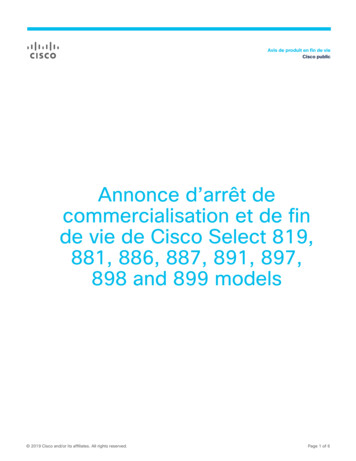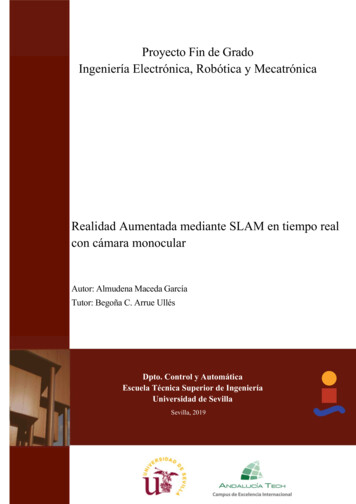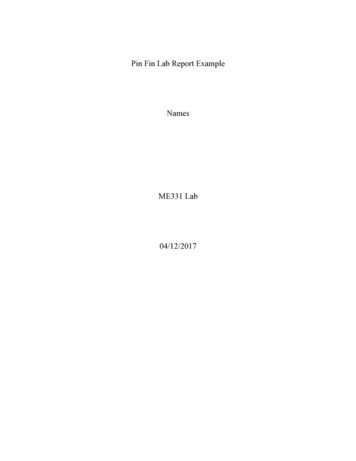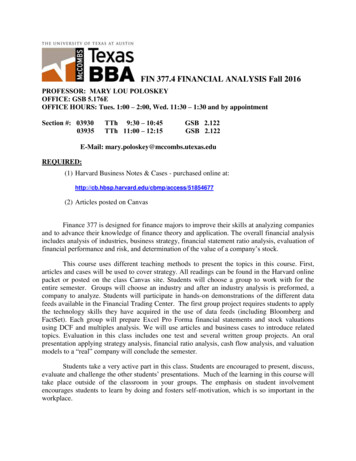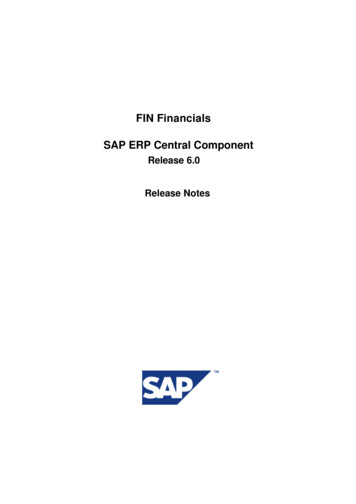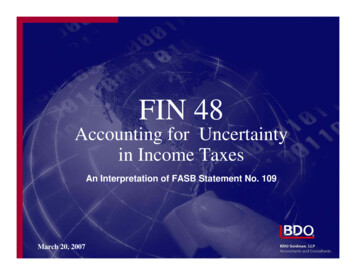
Transcription
FIN 48Accounting for Uncertaintyin Income TaxesAn Interpretation of FASB Statement No. 109March 20, 2007
Today’s AgendaOverviewHistorical GuidanceFIN 48 - OverviewDisclosuresIllustrative Guidance & TransitionQ&A2
Overview - Reason for InterpretationDiverse accounting practices inapplying Statement 109 Loss contingencies – FAS 5 Probable realization – contingent assetapproach Combination Routine tax positions – FAS 5 Structured transactions – probablerealization OtherLack of comparability3
FAS 5 Historical GuidanceAccrue “loss contingency” if: It is “probable” that an asset had been impaired or aliability incurred at date of the financial statements, and The amount of the loss can be reasonably estimatedDisclose if: One or both of the criteria to accrue not met, orexposure to loss exists in excess of the accrual, and There is a “reasonable possibility” that a loss or anadditional loss has been incurred4
FAS 5 Historical GuidanceEvaluate likelihood of future events Probable Likely to occur Reasonably possible More than remote but less than probable Remote SlightGuidance does not quantify thresholdsFAS 5 continues to be applicable for theevaluation of non-income tax reserves5
Evolution of the Exposure DraftExposure draft initially adopted a dualrecognition / derecognition threshold “Probable” threshold for recognition “More likely than not” threshold forsubsequent derecognitionDisclosures of unrecognized taxbenefits added for final Interpretation6
Overview – FIN 48FASB embraces “Asset Approach”for income taxRejects loss contingency and allother approaches for income taxClarifies and provides greaterconsistency in criteria forrecognition and measurement oftax benefits7
Overview – FIN 48Defines “tax position”Sustainable position upon examinationTechnical merits of positionRisk of detection inappropriate Likelihood of audit Likelihood of issue being foundAsset approach Recognize benefit when “recognition threshold” met Derecognition when “recognition threshold” no longermet Measure the “asset” or benefit where recognition 8threshold is met
Overview – FIN 48Two-step approach Recognition More-likely-than-not threshold MeasurementProvides criteria for subsequent recognition,derecognition and measurement Changes in judgmentProvides guidance for Interest and penalties on tax positions not recognized,but benefited on tax returns Classification Disclosure9
Scope – What is a Tax Position?Tax benefit on return filed or expected tobe filed Reduce income tax expense, taxes paid orpayable Increase tax benefit and receivable, DTA orrefundDecision not to file a returnAllocation or shift of income betweenjurisdictionsA characterization of incomeA decision to exclude income, ortreatment of a transaction, entity or otherposition as tax exempt10
Step 1 – Initial Recognition of Tax BenefitsDetermine “unit of account” Facts and circumstances in light of all available evidence Consider:Manner in which company prepares and supports tax return Approach the company anticipates the taxing authority will takeduring an examination Initial recognition threshold Will more-likely-than-not position will be sustained upon examination? Based on technical merits of the position Presumption that the tax position will be examined Look to tax law, administrative practices & precedents Evaluate each position individually, on its own merits11
“More Likely Than Not” Recognition ThresholdGreater than 50% Matter of judgment Based on facts and circumstances Consider all available evidenceA positive assertion that the reporting enterprisebelieves that it is entitled to the economic benefits ofthe tax positionPresumption of examination by taxing authorityincludes resolution of appeal or litigation process, if anyTechnical merits of a tax position are derived fromsources of authority Legislation & statutes Legislative intent Regulations, rulings, case law12
Step 2 - MeasurementFor a tax position that meets the more-likelythan-not recognition threshold Measure initially and subsequently as the largestamount of tax benefit that is greater than 50% likely ofbeing realized upon ultimate settlement with a taxingauthority having full knowledge of all relevantinformation Consider the amounts and probabilities of the outcomesthat could be realized upon ultimate settlement Based on facts, circumstances, and informationavailable at the reporting date13
Illustrative Guidance – Measurement with Informationabout Approach to SettlementScenario The enterprise has determined thata tax position resulting in a benefitof 100 qualifies for recognition andaccordingly should be measured The enterprise has considered theamounts and probabilities of theestimated outcomes.14
Illustrative Guidance – Measurement with Informationabout Approach to SettlementTable of Probabilities & Estimated ity ofOccurringCumulativeProbabilityof Occurring 1005%5% 8025%30% 6025%55% 5020%75% 4010%85% 2010%95% 05%100%15
Illustrative Guidance – Measurement with Informationabout Approach to Settlement 60 is the largest amount of benefit that is greater than50% likely of being realized upon settlementActually it’s 60 or more that is greater than 50% likely ofbeing realized upon settlement Probability of 60 itself is only 25%16
Illustrative Guidance – Measurement with Informationabout Approach to SettlementTable of Probabilities & Estimated ity ofOccurringCumulativeProbabilityof Occurring 10025%25% 7550%75% 5025%100%17
Tax Planning Strategies and Valuation AllowanceTax planning strategies Consideration required under FAS 109 Discussed in paragraphs 20-22 of FAS 109 inconjunction with future realizability of DTA, andcorresponding need for (and size of) valuationallowance If contemplated as source of future taxable income tosupport realizability of DTA, must meet recognition andmeasurement criteria of FIN 4818
Subsequent Recognition,Derecognition, & MeasurementSubsequent Recognition A tax position which previously did not meetthe recognition threshold gets recognized inthe first interim period in which: The more-likely-than-not recognitionthreshold is met by the reporting date, or The tax matter is settled through negotiationor litigation, or The statute of limitations for the tax positionhas expired A tax matter need not be legallyextinguished to subsequently recognize ormeasure a tax position Based on management’s best judgment inview of facts, circumstances, andinformation available at reporting date19
Subsequent Recognition, Derecognition,& Measurement (continued)Derecognition Derecognize (previously recognized) tax positionin the first interim reporting period in which it isno longer more likely than not that the positionwill be sustained upon examination Valuation allowance is not a substitute forderecognition Based on management’s best judgment in viewof facts, circumstances, and information availableat reporting date20
Changes in JudgmentChanges in judgment resulting in subsequent recognition,derecognition, or change in measurement of tax positiontaken previously If initial tax position was taken in prior annual period, recognizechange as “discrete” item in period of change If initial tax position was taken in prior interim period within samefiscal year, apply APB 28 (Interim Financial Reporting) and FIN18 (Accounting for Income Taxes in Interim Periods) to takechange into account over remaining periods in fiscal year usingeffective tax rate calculated for interim periodBased on evaluation of new information – not new evaluation,or new interpretation by management, of information that wasavailable in previous period21
Interest and PenaltiesInterest FIN 48 requires accrual if position in tax return is notrecognized in financial statements under FIN 48 When tax law requires interest on underpayment, startrecognizing in 1st period it would begin accruing under tax law Amount is statutory interest rate times difference between FIN48 tax position and amount taken in tax returnPenalties Recognize when tax position does not meet minimumstatutory threshold to avoid payment of penalties Recognize in period in which company claims or expects toclaim position in tax return22
Classification“Unrecognized tax benefit” concept Difference between position in tax return and benefit recognized andmeasured under FIN 48 Creates liability (or reduces amount refundable or DTA, e.g., NOL) Represents company’s potential future obligation to taxing authority fortax position taken in tax return but not recognized pursuant to FIN 48recognition/measurement guidanceLiability is current or non-current based on expected timing ofpayment of cash Current if within one year (or operating cycle, if longer)Liability recognized is generally not a deferred tax liability DTL only if it arises from a taxable temporary differenceInterest recognized under FIN 48 – Accounting policy decision to classify as either income taxes orinterest expense23
DisclosuresAccounting policy for classification of interest andpenaltiesAt the end of each annual reporting period: Tabular “rollforward” of unrecognized tax benefits(“UTBs”) at beginning and end of period Total amount of UTBs that, if recognized, would affectthe effective tax rate Total amount of interest and penalties recognized in theincome statement and balance sheet Description of tax years that remain subject toexamination by major jurisdictions Paragraph 21(d) - Positions where it is reasonablypossible that the total amounts of UTBs will significantlyincrease or decrease within 1 year of reporting date Nature of uncertaintyNature of event that would cause the changeEstimate of range of change, or statement that “can’testimate”24
DisclosuresTabular rollforward includes: Gross amts of increases & decreases in UTBs as aresult of tax positions taken during a prior period Gross amts of increases & decreases in UTBs as aresult of tax positions taken during the current period Decreases in UTBs relating to settlements with taxingauthorities Decreases in UTBs resulting from lapses in statutes oflimitations25
Illustrative Guidance - Tabular Rollforward(in millions)Balance at January 1, 2007 370,000Additions based on tax positions related to the current year10,000Additions for tax positions of prior years30,000Reductions for tax positions of prior years(60,000)Settlements(40,000)Balance at December 31, 2007 310,00026
DisclosuresRollforward/reconciliation “roadmap”? FIN 48 tabular rollforward requiresdisclosures only at aggregate level, not atindividual tax position levelNot by jurisdiction Not tax position by tax position 27
DisclosuresParagraph 21(d) Positions where it is reasonably possible that the totalamounts of UTBs will significantly increase or decreasewithin 12 months of reporting dateDisclose the nature of uncertainty (i.e. describe taxposition) Disclose the nature of event that would cause the change Estimate of range of change, or statement that “can’testimate” 28
DisclosuresParagraph 21(d) – (cont.)One of the more controversial areas of FIN 48disclosures Define ‘reasonably possible’ Includes tax positions that are both recognized as well as not yetrecognized (due to ‘reasonably possible’ range includingprobabilities above and below MLTN). “Nature of Uncertainty” – how much detail must be disclosed? Boiler-plate will not be acceptable Significant analysis, documentation and judgment All this must be performed and disclosed in the correct reportingperiod. Close scrutiny will be applied to evaluate the quality ofthe effort and conclusions arrived at in prior periods.Documentation will be an important source of evidence of past29analysis and thought process.
Effective Date and TransitionEffective for FYs beginning after December 15, 2006 e.g., calendar year 2007 companies Early adoption permitted(provided company hasn’t yet issued interim financials for that FY)Apply more-likely-than-not threshold to all income taxpositions for all open yearsRecognize cumulative effect of applying FIN 48 as anadjustment to the opening balance of retained earnings (orother appropriate components of equity or net assets in thebalance sheet)SAB 74 requires disclosure of impact of FIN 48 on publiccompany financial statements30
Illustrative GuidanceGuidance provided in illustrations Unit of Account and the Two-StepProcess Subsequent event Differences related to timing31
Illustrative Guidance – Unit of AccountUnit of Account and the Two-Step Process Facts: Four R&D Projects (A,B,C,D) Each project is a separate “Unit of account” Recognition: determined at unit of accountProjects A, B & C: Meet Recognition Threshold Projects D: Does not meet Measurement: determined at unit of accountProjects A, B, C: Record benefit based on ‘best estimate’ Projects D: No benefit recorded, even though it is thoughtthat a portion of D’s credit may be sustained Take-away The recognition determination is made for each unit ofaccount. Unit of account determined based on facts andcircumstances of issue in question.32
2 Step ApproachValuation versus Validity When an issue?Goodwill versus other intangibles Cross border activities - transfer pricing Contributions Validity (Recognition) Ability to assign FV is based upon clear unambiguous taxlaw - meets MLTN recognition requirement Valuation (Measurement) FV requires ‘best estimate’ determination Take-away Even when the recognition threshold is met for valuations,the best estimate must be determined based onsupportable data.33
Illustrative Guidance – Subsequent EventReporting Subsequent Events FactsStatutes closed through 2001IRS exam 2002-2004 during 2007Tax position MLTN recognition met – matter in litigation byanother company Unfavorable Litigation outcome in Q1 of subsequent yearbefore report issued Evaluation At the reporting period, 12/31/07, management evaluatedposition and determined MLTN criteria met and positioncould be upheld Take-away Subsequent recognition, derecognition and measurementoccurs based on facts, circumstances and informationavailable at the reporting date.34
Illustrative Guidance – Timing of Deduction andAssociated Deferred ItemsDifferences Related to Timing Example FactsAsset purchase identifies newly acquired goodwill, fully deductedin first year on tax return Not amortized for book Recognition Recognition threshold not met, which would have provided for 15year amortization Measurement Deferred tax liability is based on ‘best estimate’ (15 yramortization), and the difference to the ‘as filed’ amount is shownin non-current tax liability Take-away An accrual for uncertain tax positions is recorded for the differencebetween the tax return as filed and a hypothetical tax return based35on MLTN positions. Deferred taxes are recorded for differencesbetween the hypothetical tax return and GAAP treatment.
DocumentationAU 9326 Evidential Matter .13 “ the auditor’s documentation should includesufficient evidential matter about the significantelements of the client’s tax exposure analysis.” Sufficient, competent, evidential matter about assertionsin the financials statements of material significance –i.e., documentation and supportFIN 48 Document tax positions – where book and tax treatmentdiffers and for items treated the same as book Make assessments as to whether tax benefits can berecognized and when36
404Document processesControls adequateCOSO assertions met OccurrenceExistenceCompletenessValuation or AllocationRights & ObligationsPresentation &Disclosure37
Implementation ObjectivesInventory tax positionsClassify Uncertainty Complexity MaterialityEvaluate existing analysis and documentationAddress gapsUse a controlled processQuantify cumulative effectConsider impact on controls/40438
Workplan ResourcesTeamManagementPeopleTrainedAccounting and TaxResourcesSubject Matter ExpertsEducated on key issuesTeam leader / pointpersonCommunicationProcessTailor work programSupport & DocumentTechnical & law updatesQuantifyTechnologyAutomated processReduced mechanicalerror risksKnowledgeDataTechnical KnowledgeDataControlled objectivesControlled dataReview proceduresRepresentationsConsistent informationFile accessRecord retentionObjectives:Controlled ProcessApproval & 404 Controls39
Assessment40
Implementation Issues - R&DStatus of Federal CreditIdentify Scope All open tax years identified Statutes of limitation differ by state California: four years Carryforwards Carryforwards from years with NOLsIdentify Appropriate Unit(s) of Account41
Implementation Issues - R&DWhich unit(s) of account will you use to quantify your Company’sresearch credit positions and/or qualified research expenses(“QREs”)? Projects IRS considers following units when sampling on exams: In-house & vendorEnhancement & maintenanceCommercial & internal use softwareCost centers/departmentsActivitiesElements of qualified process of experimentation Tying units of account to statute Job titlesContractors or contractsOther expense types, for example:Above-first-line managers Highly-paid employees Prototypes Patent-related costs 42
Implementation Issues - R&DRecognition – Technical Issues QREs Methodology for identifying IRS Briefing Paper on Taxpayer Approaches to Capturing Costs forthe Research Credit Reliably excludes all non-qualified costs while including all qualifiedcosts Prototype expenses: depreciable property? Extraordinary utilities: “merely comparing the square footageelectricity use in an administrative building with a research facilityis insufficient.” QREs must relate to qualified research Qualified Research Non-core R&D, e.g., marketing, manufacturing, QA, fieldengineering Direct supervision: above first-line manager Job titles/org charts are not uniquely dispositive Direct support: e.g., patent expenses, secretary expenses43
Implementation Issues - R&DRecognition – Technical Issues(cont.) Calculation All relevant entities included Members of “controlled group ofcorporations” More than 50% stock ownership, notjust 80% Members of “group under commoncontrol” Base amount correctly calculated Fixed base % Start-up or not “Gross receipts” used Expansive definition Acquisitions and dispositionsaccounted for44
Implementation Issues - R&DMeasurement Documentation Inadequate or poor documentation may cause the amountultimately to be realized upon exam to be less than the amountpermitted to be recognized on the merits of the tax law Leverage existing documentation Create roadmap or bridge between existing company documentationand legal tests Identify and document QREs using statutorily-explicit elements,viz., elements of a qualified process of experimentation Consistency provision404 Controls Identification Documentation Leverage existing accounting and documentation systems45
Implementation Issues - InternationalIdentify scope Jurisdictions Country-by-country Branches Statutes of limitations All open tax years Statutes of limitation differ bycountry Non-filing with no statutes oflimitations Law In each country Treaties Competent authorityAdministrative Guidance46
Implementation Issues - InternationalIdentify issues Transfer Pricing For all countries Group by similar transactions (sale byproduct line, services, intangibles, etc.) Foreign Tax Credits Eligible tax Expense allocations Overall foreign loss Supply Chain Restructuring Permanent establishment risk of principal Transfer pricing risk Section 367 Currency and Exchange Gain and Loss47
Implementation Issues - InternationalIdentify issues (cont.) ETI positions/ IC DISC positions Foreign Economic Processes Qualifying sales U.S. content I
Mar 20, 2007 · SAB 74 requires disclosure of impact of FIN 48 on public company financial statements. 31 Illustrative Guidance Guidance provided in illustrations Unit of Account and the Two-Step Process Subsequent event Differences rela

